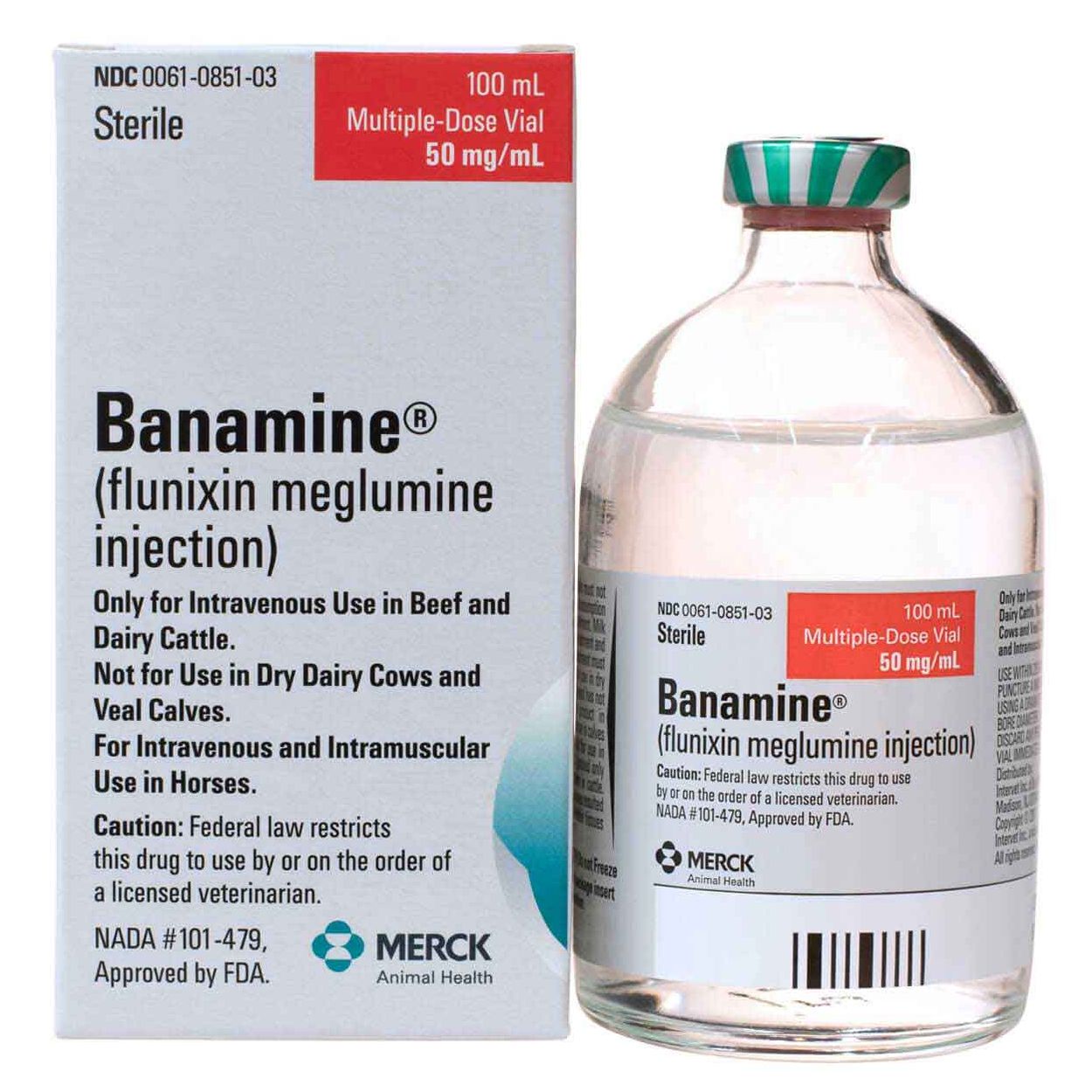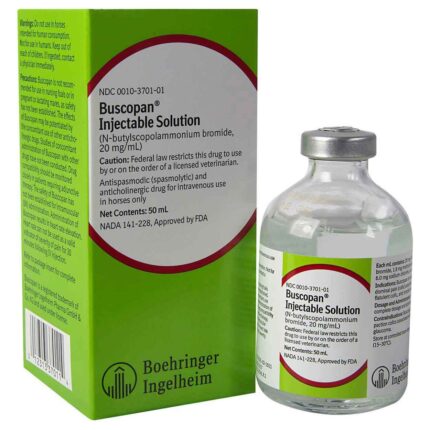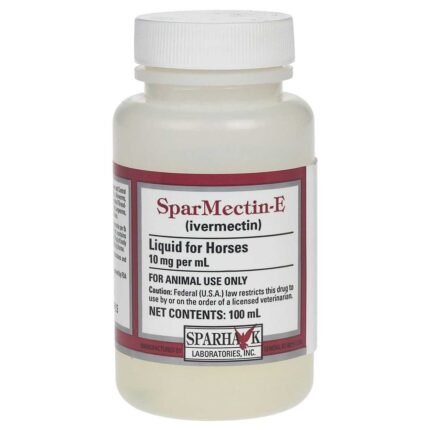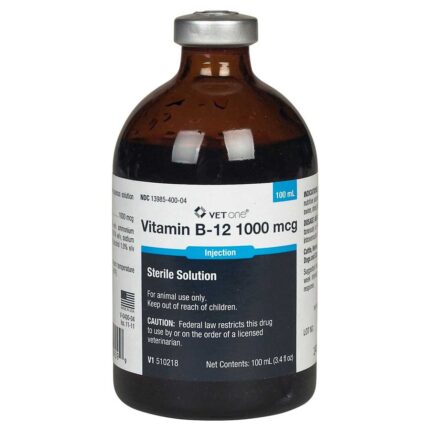Banamine (Flunixin Meglumine)
$25.99
| 134RX ** | 50mg/ml 100 ml | $28.99 | |||
| 961RX ** | 50mg/ml 250 ml | $58.99 |
Banamine (flunixin meglumine) injectable solution is an anti-inflammatory and analgesic. Flunixin meglumine for horses is used in the alleviation of inflammation and pain associated with musculoskeletal disorders and for the alleviation of visceral pain associated with colic.
Banamine (Flunixin Meglumine)
Banamine (Flunixin Meglumine) Description
Each milliliter of BANAMINE Solution Injectable contains: Active ingredient: 50 mg flunixin equivalent to 83 mg flunixin meglumine USP; Non-medicinal Ingredients: 0.1 mg edetate disodium, 2.5 mg sodium formaldehyde sulfoxylate, 4.0 mg diethanolamine, 207.2 mg propylene glycol; 5.0 mg phenol as preservative, hydrochloric acid, water for injection q.s.
Banamine Solution Injectable Indications
Horses
BANAMINE Solution Injectable is recommended for the alleviation of inflammation and associated pain in musculoskeletal disorders in the horse. BANAMINE Solution Injectable is also recommended for the alleviation of visceral pain associated with colic in the horse.
Cattle
BANAMINE Solution Injectable is indicated for the control of pyrexia associated with Bovine Respiratory Disease (BRD), endotoxemia and acute bovine mastitis. BANAMINE Solution Injectable is also indicated for the control of inflammation associated with endotoxemia. BANAMINE Solution Injectable used as an adjunct to antibiotic therapy with oxytetracycline has been demonstrated to control pyrexia associated with bovine respiratory disease.
Action
Flunixin meglumine is a potent, non-narcotic, non-steroidal, analgesic agent with anti-inflammatory activity. Antipyretic activity has been demonstrated in cattle and in laboratory animals. It is significantly more potent than pentazocine, meperidine and codeine as an analgesic in the rat yeast paw test.
Horse
Flunixin is four times as potent on a mg per mg basis as phenylbutazone as measured by the reduction in lameness and swelling in the horse. Plasma half-life in horse serum is 1.6 hours following a single dose of 1.1 mg/kg. Measurable amounts are detectable in horse plasma at 8 hours post injection.
Cattle
Flunixin meglumine is a weak acid (pKa = 5.82) which exhibits a high degree of plasma protein binding (app. 99%). However, free (unbound) drug appears to readily partition into body tissues (Vss predictions range from 297 to 782 mL/kg). Total body water is approximately 570 mL/kg. In cattle, elimination occurs primarily through biliary excretion. This may, at least in part, explain the presence of multiple peaks in the blood concentration/time profile following IV administration.
Cattle
In healthy cattle, total body clearance has been reported to range from 90 to 150 mL/kg/hr. These studies also report a large discrepancy between the volume of distribution at steady state (Vss) and the volume of distribution associated with the terminal elimination phase (Vβ). This discrepancy appears to be attributable to extended drug elimination from a deep compartment. The terminal half-life has been shown to vary from 3.14 to 8.12 hours.
Model and field studies have shown that flunixin can have short-term effect in the control of some inflammatory factors associated with endotoxemia and irritation (carregeenan).
Flunixin persists in inflammatory tissues and is associated with anti-inflammatory properties which extend well beyond the period associated with detectable plasma drug concentrations. These observations account for the counterclockwise hysteresis associated with flunixin’s pharmacokinetic/pharmacodynamic relationship. Therefore, prediction of drug concentrations based upon the estimated plasma terminal half-life will likely underestimate both the duration of drug action and the concentration of drug remaining at the site of activity.
Banamine Solution Injectable Dosage And Administration
Horses
The recommended dose for musculoskeletal disorders is 1.1 mg per kg (1 mL/45 kg) of body weight once daily. Treatment may be given by intravenous or intramuscular injection and repeated for up to 5 days. Intravenous studies show that the onset of activity is within 2 hours. Peak response occurs between 12 and 16 hours and duration of activity is 24 to 36 hours following intravenous and intramuscular administration.
The recommended dose for the alleviation of pain associated with equine colic is 1.1 mg per kg of body weight. Intravenous administration is recommended for prompt relief. Should colic symptoms recur, treatment may be repeated as necessary. Clinical studies show that pain symptoms were alleviated in 37% of treated horses within 15 minutes, and 74% within 30 minutes. The cause of colic should be determined and treated with concomitant therapy.
Cattle
The recommend dose for control of pyrexia associated with bovine respiratory disease and endotoxemia and control of inflammation associated with endotoxemia in cattle is 2.2 mg flunixin per kg (2 mL/45 kg) of body weight given by slow intravenous administration once a day for up to 3 days. The total daily dose should not exceed 2.2 mg/kg of body weight. Avoid rapid intravenous administration of the drug. Twenty-four (24) hours after administration, check if animal is febrile. Re-administer only if the fever is 104°F (40°C) or higher.
The recommended dose for control of pyrexia associated with acute bovine mastitis is 2.2 mg flunixin per kg of body weight given as a single intravenous injection. Administer slowly.
Contraindications
Horse
call a halt to administer intra-arterially. Inadvertent intra-arterial injection may cause adverse reactions. Signs can be ataxia, incoordination, hyperventilation, hysteria, and muscle weakness. Signs are transient and disappear without antidotal medication within a few minutes. Do not use in horses showing hypersensitivity to flunixin meglumine.
Cattle
Stop administer intra-arterially. Inadvertent intra-arterial injection may cause adverse reactions. Do not use in cattle showing hypersensitivity to flunixin meglumine. The drug is contraindicated in animals with hepatic disease, renal and cardiovascular impairment, gastro-intestinal ulceration and/or platelet disorders. It is also contra-indicated in dehydrated animals.
Precautions
The use of NSAIDS may be associated with gastro-intestinal and renal toxicity. Patients at greatest risk for renal toxicity are those that are dehydrated, on concomitant diuretic therapy or those with renal, cardiovascular, and/or hepatic dysfunction. Due to the potential for NSAIDs to induce gastro-intestinal ulceration, concomitant use of this drug with other anti-inflammatory drugs, such as other NSAIDs and corticosteroids should be avoided. With the exception of the antibiotic oxytetracycline in cattle, studies to determine the activity of BANAMINE when administered concomitantly with other drugs have not been conducted. Drug compatibility should be monitored closely.
Discontinue use if hematuria or fecal blood are observed. Avoid rapid intravenous administration of the drug.
Horses
The effect of BANAMINE on reproduction in horses has not been determined. Studies on reproduction in rats and rabbits have shown no teratogenicity.
Cattle
Do not use in bulls intended for breeding as reproductive effects of BANAMINE in this class of cattle have not been investigated. NSAIDs are known to have potential effects on both parturition and the estrous cycle. There may be a delay in the onset of estrus if flunixin is administered during the prostaglandin phase of the estrous cycle. The effects of flunixin on imminent parturition have not been evaluated in a controlled study. NSAIDs are known to have the potential to delay parturition through a tocolytic effect. Do not exceed the recommended dose.
Side Effects
During clinical studies no significant side effects were reported when the drug was injected slowly. In cattle, a temporary head thrashing can occur if the drug is injected too rapidly.
Toxicity
No toxic effects were observed in rats given intramuscular flunixin 4 mg/kg/day for 28 days. No adverse effects were seen in dogs given a single intramuscular injection of 50 mg/kg. Higher doses resulted in salivation, panting, emesis and tremors. No toxic effects were observed in monkeys given intramuscular doses between 3 and 30 mg/kg per day for 28 days.
Horse
Prolonged parenteral treatment in horses at 4.4 mg/kg body weight showed no untoward effects.
Cattle
No flunixin-related changes (adverse reactions) were noted in cattle administered a 1X (2.2 mg/kg) dose for 9 days (three times the maximum recommended duration for bovine respiratory disease and endotoxemia and nine times the maximum recommended duration for acute bovine mastitis).
How Supplied
BANAMINE Solution Injectable, 50 mg flunixin/mL (equivalent to 83 mg flunixin meglumine/mL) is available in 50, 100 and 250 mL multidose vials.
Storage
Store between 2° and 30°C (36° and 86°F).
Related products
Acepromazine for Dogs, Cats & Horses
Depo-Medrol for Dogs & Horses
Hydroxyzine Pamoate
Marquis Antiprotozoal Oral for Horses
| 1215RX ** | 1 ct | $362.49 | ||
| 429RX | 4 ct | $1,289.09 |
Minocycline Hydrochloride Capsules
| 1241RX | 100 mg 50 ct | $29.99 | ||
| 1234RX | 100 mg 500 ct | $158.95 |
Neo-Poly-Dex Ophthalmic
Protazil Antiprotozoal for Horses
Vitamin B-12 for Animal Use
| 627RX | 1,000 mcg per ml 100 ml | $11.49 | ||
| 849RX | 3,000 mcg per ml 100 ml | $23.99 | ||
| 739RX | 3,000 mcg per ml 250 ml | $38.99 |












Reviews
There are no reviews yet.